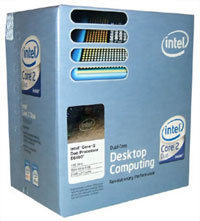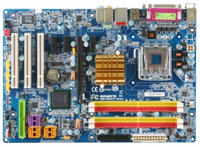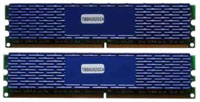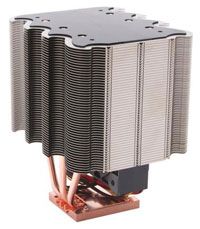Midrange Overclocking Configuration
The final category we have to talk about involves everyone's favorite topic: overclocking. We have shown in
recent articles that certain CPUs can outperform processors that cost six times as much once you add in overclocking. A lot of people also like the thought of getting "something for nothing," so we will conclude this Buyer's Guide with some upgrades intended to help you get the most out of your overclocking endeavors.
| Intel Mid-Range Overclocking System |
| Hardware |
Component |
Price |
Rebates |
| Processor |
Intel Core 2 Duo E6400 (2.13GHz 2MB Shared) - Retail |
$223 |
|
| Heatsink |
Tuniq Tower 120 |
$55 |
|
| Motherboard |
Gigabyte GA-965P-DS3 (P965 775) |
$138 |
|
| Memory |
Super Talent 2x1GB DDR2-800 (T800UX2GC4) |
$268 |
|
| Video Card |
eVGA GeForce 7600GT 256MB (256-P2-N550 -T2) |
$131 |
|
| Hard Drive |
Seagate 320GB SATA 3.0Gbps 7200RPM 16MB (Barracuda 7200.10) |
$90 |
|
| Optical Drive |
LG Black 18X DVD+R (GSAH22N-BK) |
$36 |
|
| Case |
Antec Solution SLK3000-B |
$76 |
|
| Power Supply |
OCZ GameXStream 700W (OCZ700GXSSLI) |
137 |
|
| Display |
Acer AL2016W 20" 8ms (1680x1050) |
$233 |
|
| Speakers |
Logitech X-530 5.1 70W Speakers |
$74 |
|
| Keyboard and Mouse |
Microsoft Comfort Curve 2000 B2L-00047 |
$28 |
|
| Operating System |
Windows XP MCE 2005 (with Vista coupon) |
$115 |
|
| Bottom Line |
|
$1604 |
$1604 |
 |
So far in this guide, AMD platforms have been a reasonable alternative to Intel's Core 2 Duo platform. They may not be faster in many cases, but at the lower end of the dual core spectrum the price/performance is nearly identical when comparing Athlon X2 and Core 2 Duo. Once you add in overclocking, however, there's no way that we would currently recommend AMD over Intel. There are still some AMD chips that can achieve impressive overclocks - one of our editors for instance is running an Athlon X2 4000+ (2.0GHz 1MB cache stock) at 3.08 GHz - but with many Core 2 Duo overclocks reaching 3.5 GHz and higher AMD is not currently able to match that level of performance, short of resorting to phase change cooling.
 |
Besides the processor, there are several critical components that can help increase overclocking potential as well as providing improved stability. First of course is the motherboard, which almost goes without saying. A great chipset alone can't provide for excellent overclocking, and at the same time the world's best BIOS programmers can't overcome chipset limitations. When you get a great chipset with an excellent motherboard design and the proper BIOS, however, the results can be extremely impressive. There are motherboards that overclock better than Gigabyte's GA-965P-DS3, but with the latest BIOS update and the price of under $150 it is very difficult to beat the DS3. The ASUS P5B-E we mentioned previously is a close second; the DS3 costs a bit less and overclocks a bit further, while the ASUS has a few more features.
 |
Next on the upgrade requirements for overclocking has to be memory. You can get some very respectable overclocks using just about any DDR2-800 memory, but if you want to push into the 500MHz bus speed overclocks and beyond, you'll need memory that can function at DDR2-1000 and higher. As this is a midrange guide, we didn't want to go to extreme on the memory side of things, but the Super Talent memory we mentioned previously can easily reach DDR2-1000 at 2.2V and we feel that's sufficient given our other components. Using a 1:1 memory:bus ratio (which is typically optimal for overclocking), DDR2-1000 means you can run a 500MHz bus. You may have noticed that we didn't select an E6300 processor, and the reason is that we don't want the RAM and bus speed to be the limiting factors. An E6300 with a 500MHz bus would be running at 3.5 GHz, and while that's certainly an impressive overclock we prefer the 8X multiplier of the E6400. It is doubtful that you will be able to run most E6400 chips at 4.0GHz, but hitting somewhere around 3.6-3.7 GHz isn't uncommon.
 |
The last two items that are important when looking at maximum overclocking are CPU/system cooling and the power supply. The stock Intel heatsink performs quite well, but it's still not able to match the cooling prowess of the better aftermarket solutions. As we showed in our recent article, the
Tuniq Tower 120 was able to dramatically lower processor temperatures, and it also improved overclocking headroom by about 200MHz. It manages to do this without generating a lot of noise, and for a cost of about $60 it provides a far better long-term overclocking solution than the stock heatsink. In order to overclock most CPUs beyond a certain point, it is necessary to increase the processor voltage. This in turn increases the heat generated by the CPU, so adequate cooling becomes even more critical. Large aftermarket heatsinks like the Tuniq Tower 120 may be a bit more difficult to install, but they are still highly recommended for anyone looking to push their CPU to the limit.
 |
Increasing processor and memory voltages naturally puts a larger strain on the power supply. Several of the other editors have burned through quite a few power supplies during overclocking attempts, especially at the more extreme end of the equation. When we looked at upgrading the power supply to something that would be suitable for intense overclocking, we found that most of the 500W to 600W power supplies really didn't cost much less than the 700W PSU that we selected. The Fortron Source FX700-GLN is essentially the same power supply as the OCZ GameXStream 700W, and it's priced about the same. However, the Fortron Source comes with a two-year warranty while OCZ has a three-year warranty, so the choice is pretty clear.
We stuck with a pretty average GPU on our overclocking system - faster than the base 7600GS, but a 7600GT is by no means a graphics powerhouse these days. NVIDIA cards typically overclock better than AMD offerings, but the 7600GT is already factory overclocked and probably can't get much faster. If you want to get a high-performance GPU with more overclocking headroom, the GeForce 8800 GTS cards appear to be the best bet right now. They're already fast at stock speeds, but overclocking has helped quite a few people reach near 8800 GTX performance levels at 2/3 the cost. As always, your mileage may vary, and we would tend to be a bit more cautious with overclocking GPUs as opposed to CPUs.
So what's the bottom line when it comes to overclocking? For about $300 more, you can most likely get a Core 2 Duo E6400 to run twice as fast as the stock E6300. Individual results will of course vary, as no two processors are identical, but we are reasonably confident that knowledgeable overclockers will be able to hit 3.6 GHz or more with this particular configuration. If you wanted to stick with the basic Intel configuration we listed and simply overclock that, you could probably hit 2.8 GHz before running into the limitations of the memory and motherboard, but you would also end up with a processor that was running somewhat warm. Before you go out and jump on the configuration we just listed, however, keep in mind that the Core 2 Duo E4300 will be available shortly with a lower price, and with the lower base front side bus speed and a 9X multiplier it should be able to reach 9x400 (3.6 GHz) simply by adding a better aftermarket heatsink.
Conclusion
We've covered no less than five potential system builds in this Midrange Buyer's Guide, and still we haven't covered every possibility. However, with the information we've provided, you should now have enough information to get started building your own ideal midrange computer. As always, comments and questions are welcome. There are always new products launching, and some of those will surpass the components we have selected here, but for now these component choices offer some of the best bang for the buck on the market.















43 Comments
View All Comments
dm - Friday, January 19, 2007 - link
Hey, I like this article. Very nicely written and "right on time"!!! Btw, if I may request, could you guys make a write up about "specialized" items? I mean, like this pico PSU and Mini-ITX combo:http://fanboyreview.blogspot.com/2006/01/tech-link...">http://fanboyreview.blogspot.com/2006/0...link-pow...
http://fanboyreview.blogspot.com/2006/02/press-rel...">http://fanboyreview.blogspot.com/2006/0...ss-relea...
I'd love to see you guys build one, bring it to the test bench, and tell use where to get those parts. I just can't find them :(
Le Québécois - Friday, January 19, 2007 - link
I think this is the first Buyer's guide from Anandtech.com that I read that doesn't completely include both Intel and AMD. Yes it still mention what AMD could be use if you don't go with the listed Intel configuration but it doesn't tell you the price or what motherboard you should buy if you would choose to go with AMD. I know AMD is not the best way to go right now but still I find this a little confusing when I go back in the "Mid-Range Buyer's Guide, September 2005" and find this :But still that guide provided us with both Intel and AMD options.
Yes AMD is on the first page with Intel but it's the only page for this guide. What's happening to Anandtech integrity? Or it's just the way every guides will appear from now on even if AMD manage to get back at Intel?
If it's the case, I don't think it's a good idea because some peoples are fanboys and will never go with AMD or Intel and leaving out either Intel or AMD from a guide may leave these persons in the dark since many of them don't take times to read every articles that are published on Anandtech.
JarredWalton - Saturday, January 20, 2007 - link
Honestly, I got tired of putting together system configurations that I really wouldn't recommend. The AMD configuration listed is very good for a midrange PC, so I included it. As a gaming platform, AMD is still fine, but if you want a high-end gaming system would you really want to pair it with a lesser CPU? Overclocking there's really not much point in getting a new AMD right now, I don't think - some of the lower end parts and the Opteron models can overclock pretty well, but when Core 2 leads in clock-for-clock comparisons and you can usually get an extra 500+ MHz out of it, it's just not even close.Really, I thought it would be more interesting to take a look at several different options for a midrange computer rather than doing the same old thing again. The way I see it, most of the changes made are minor upgrades to the CPU/mobo, so only the other parts are really changing. You could use the base AMD system and make the same upgrades, only keep the mobo constant, and you'd pretty much be fine. I still have several dozen PCs that have AMD processors and only one Core 2 of my own, for what it's worth. (No need to upgrade any of the systems right now, as they're fast enough.)
yyrkoon - Sunday, January 21, 2007 - link
This is from a motherboard that you guys recently did a spot light on in one of your CES articles. 900MHZ - 1.1 GHZ is a bad overclock ?
http://www.newegg.com/Product/CustratingReview.asp...">http://www.newegg.com/Product/CustratingReview.asp...
Post #5, and I suppose someone could possibly fabricated their review, but this one person isn't the only person on newegg claiming this motherboard is a very good overclocker, perhaps you guys should convince AMD + ABIT sending you parts for review ?
Now, on the reverse side, I'm still not quite sure it is worth investing in an AMD CPU for overclocking, Intels current CPUs seem a bit cheaper overall, but hey, the opterons might not be fully supported on this motherboard, but they seem to be working, and quite well, according to several reviewers.
JarredWalton - Sunday, January 21, 2007 - link
You can get Opterons to hit ~3.0GHz with pretty much full stability, but when those cost as much as an E6400 that will hit 3.5+ GHz with full stability, it's pretty clear why we think Core 2 is the better overclocking choice. A 50% or higher overclock is nothing to scoff at, but E6300 is basically only limited by motherboard and RAM in many cases, and E4300 ought to hit 100% overclocks routinely. (Yikes!)yyrkoon - Sunday, January 21, 2007 - link
Yeah, I never said it was a viable comparison, but for die hard AMD fans, its definately an option. I mean, what I would really like to see, is some real world hard data, on an Opteron vs maybe each of the conroe CPUs. I've little doubt, all CPUs overclocked, that every Conroe would outperform anything AMD, however, how much of a real world difference would it really make ?Some of us have already invested into AM2 systems, and could upgrade a good bit cheaper to an Opteron, vs. a C2D CPU, so the real question is, is it really worth the cost of the motherboard, to go that route, instead of just buying an Opteron? We've all seen your game numbers for FPS etc., but would those numbers really translate into a hugely noticeable difference ?
I for one, if gone C2D, would buy a top of the line i680 board (most likely ABIT), and probably an E6600, if gone AMD, an Opteron 1214-1216 (I like the even numbered, higher multiplier on the 1216), and the ABIT motherboard mentioned above. Also, since my business partner here just purchased the that ABIT AM2 board, I have the luxury of seeing it in action, before I purchase for myself.
Also, since i payed only $54 for my current system board, and not very much for the single core 3800+ im currently using, its not as though I'm out a whole lot, no matter what I do. One thing is for sure however, this motherboard WILL get replaced, I'm not too fond of it, and its not very stable compared to anything I've owned from ABIT.
JarredWalton - Monday, January 22, 2007 - link
How much of a difference it would make depends largely on what sort of application you're running, as well as the other hardware in the system. If you don't have a top end graphics configuration and you're worried about gaming performance, in most cases the difference between the various current processors is going to be very small. If you're running a couple of 8800 GTX cards, the difference could be quite a bit larger depending on resolution. I figure anyone that has the money to buy a couple of 8800 GTX GPUs should probably already have at least an E6600 processor, because if you're willing to spend that much money on graphics cards $300 on a processor doesn't seem like a whole lot.Other applications (3D rendering, video encoding, office tasks) will show more or less of a difference. Core 2 Duo should be faster in most of those, especially with overclocking, but if you never happen to run any of those tasks it really doesn't matter much. If you already have a decent AM2 setup and can hold out, I would be far more interested in waiting to see what the K8L processors can manage to do -- granted that appears to be about six months out, but I doubt anything significant is going to happen in the software market before then that would necessitate a CPU upgrade. (Maybe Vista might do it?)
yyrkoon - Monday, January 22, 2007 - link
Yeah, well I for one, am not too enthusiastic about the socket F platforms (assuming this is what you mean about K8L). I used to follow the road maps of each side, to the point that I would be easily disappointed when the chips actually arrived. Now, I just wait, and see what happens when it happens, at least, for CPUs. Personally, the technology I've been following for a while, thats not due out until perhaps quarter 3 is PCI-E v2.0, and the PCI-E to PCI-E peer to peer communications (potential of 160Gbit/s throughput . . .). Something tells me though, that either 1) this technology will be further out than quarter 3, 2) is all smoke an mirrors, 3) will cost WAAAAY more than 10GbE currently costs now.Anyhow, my point basically is, you can wish in one hand, and .... in the other, and see which one fills up faster. In other words, it wont happen, until it happens :)
JarredWalton - Tuesday, January 23, 2007 - link
I'm pretty sure AMD is going to release some sort of updated CPU (quad core maybe - not sure on that) for AM2 round about summer time. My understanding (which admittedly could be wrong) is that K8L will be available for socket F as well as AM2, just like the current K8 line. Socket F just supports multiple CPU sockets whereas AM2 is for single chips. That's why we have Opteron 12xx parts for AM2 and 22xx/82xx for socket F.As for PCI-E stuff, most of the new items won't really matter on the desktop. It's like having a PC with 80GB/s of memory bandwidth; if the CPU only needs 5-8GB/s everything else is just wasted.
Le Québécois - Saturday, January 20, 2007 - link
OK, thanks for taking some of your time to explain why you did this. I don't have any things personal against this approach since I do read every one of Anandtech articles and have no problem building a computer on my own.I understand you got tired of writing about 2 differents builds of computer (AMD and Intel) for every guide even if one of those isn't a good choice (computing power or cost). I just found it odd to see it at this time when AMD is no so bad (I would buy a Core 2 Duo if I was looking for a computer right now but I'm still not ready to change my old one) and not a some times ago when Intel was like AMD is today, if not worst, like in the Buyer's Guide where I took my quote from.
Now if I think about it, maybe it's a good thing since it will force the fanboys to do some real research before blindly buying AMD or Intel just because of the name.
One last thing, when you say :
Are you saying that you personally own those PCs?
If so can I ask what are you doing with such an amount of PCs?